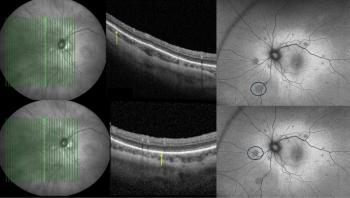
Moran Eye Center researcher plays role in AI use in eye care
Researcher Adam Dubis, PhD, from John A. Moran Eye Center, is playing a role in the use of artificial intelligence (AI) in eye care.1 Dubis cofounded German-based health tech company deepeye Medical GmbH, which has gained European Union (EU) Medical Device Regulation (MDR) for its ophthalmology AI algorithm for the treatment of neovascular
The assistant is designed to close the gap between real-world outcomes and trial data by reducing patient dropout via enhancing efficiency and, potentially, the effectiveness of intravitreal injection therapy planning, Ophthalmology Times Europe
deepeye Medical’s Treatment Planning Support (TPS) product is the first predictive AI tool for ophthalmology therapy management that has been approved for clinical use in the Western world, a press release said.1
Dubis has applied for deepeye’s TPS to be tested at Moran Eye Center clinics as a step toward US Food and Drug Administration (FDA) approval.1
When using the AI therapy planning assistant, medical assistants send spectral domain OCT scans of nAMD through the system in 1 to 2 clicks. After upload, the AI assistant analyses the automatically pseudonymised OCT and generates a report that contains the assessment of disease activity for 1-glance therapy decision support, biomarker visualization for explainability of AI recommendation, 12-month therapy need prognosis to support patient education, trend diagrams on therapy progress, and a text summary to accelerate documentation.2
“This is an exciting milestone in the collective global effort to ethically source and provide physicians with data in a way that can advise treatment and improve care,” Dubis said in a press release.1
AMD is a leading cause of blindness in people 55 years and older, but not all patients respond to the same treatment regimen. The creation of the deepeye TPS included the use of tens of thousands of 3D scans of the retina in combination with medical records to analyze nAMD progression in correlation with treatment. The final algorithm offers physicians help in making 2 decisions, “acting like a second expert reader of the scans,” a press release said.1
- Does the person need to receive the next treatment sooner than the last one, or can the time between appointments be extended?
- How many treatments will the patient need over the next 12 months?
“The idea is that it will allow patients to keep their vision as long as possible and ensure they are only spending time going to a clinic when they need to,” Dubis said.1 “For physicians, it optimizes clinic flow, provides reassurance for the treatment course, and possibly helps in patient education or justifying therapy switching.”
deepeye TPS is the result of inspiration sparked by the IVI-Portal of the Eye Center at St. Franziskus-Hospital Münster, which has helped triple visual acuity gains and double therapy adherence compared to other real-world studies when conducting double readings of optical coherence tomography (OCT) imaging.1 It gained European approval after an international group test of more than 300 patients. Ophthalmologists who participated in the study at Ludwig Maximilian University Eye Clinic in Munich agreed with the recommended treatment adjustments from deepeye TPS 56% of the time.1
“Most physicians treating wet AMD are trying to personalize medicine by testing and seeing what works, but if we have some predictors, that could help us get there more quickly or more safely,” said Eileen Hwang, MD, PhD, retina specialist and researcher at Moran Eye Center.1
Hwang noted a cautionary view against AI as a sole solution, saying, “Nothing is going to be 100%. We need to keep our minds open that even AI is a prediction that could be wrong, just like when a physician makes a decision to inject or not to inject a patient on a given day.”
Another deepeye Medical product that leverages AI is deepeye Research, which is designed to empower retinal therapy study teams with actionable insights through the means of utilizing advanced AI in complex data sets.2 The AI solution builds on proven methodologies that are involved in major phase 3 and 4 anti-VEGF trials in the EU. The solution works within the 4 pillars of advanced retinal research, which include comprehensive data input; anonymized, standardized output; an AI platform for research; and AI-powered insights. For data input, deepeye Research is integrated with large, heterogeneous OCT imaging and clinical data sets, with the output being anonymized, standardized, and enhanced imaging data.2
At the Moran Eye Center, Dubis’ lab has created the Moran Phenotyping, Imaging and Advanced Technologies (PHIAT) database1, which is an anonymized AI database that can be queried by researchers studying a myriad of ophthalmology-related questions. In PHIAT, individual health records are de-identified, and data confidentiality is protected. Ethically sourced data gathering is of importance to Dubis, who explained that PHIAT is unique among academic medical centers.1
“While other universities have limited databases open to research access, the data is preconfigured, whereas PHIAT Is not,” Dubis said.1 “This allows for a much broader range of inquiry and investigation.”
“Ophthalmology in particular is a field where we rely heavily on imaging of the eye, which has seen tremendous advances in the past decade,” said Randall J. Olson, MD, CEO and distinguished professor and chair of ophthalmology of Moran Eye Center.1 “AI can assist with correlating these images to disease progression and to find those patterns that will better inform our treatment plans. Simply put, this is the future, and we are investing in it.”
Reference:
Marketing and Communication. Moran Eye Center Researcher Helps Create First AI Tool of Its Kind Used in Eye Care. Moran Eye Center | University of Utah Health. Published July 11, 2025. Accessed July 15, 2025.
https://healthcare.utah.edu/moran/news/2025/07/moran-eye-center-researcher-helps-create-first-ai-tool-of-its-kind-used-eye-care Joy J. EU issues CE mark for AI therapy planning assistant from deepeye Medical. Ophthalmology Times. Published June 2, 2025. Accessed July 18, 2025.
https://europe.ophthalmologytimes.com/view/eu-issues-ce-mark-for-ai-therapy-planning-assistant-from-deepeye-medical
Newsletter
Keep your retina practice on the forefront—subscribe for expert analysis and emerging trends in retinal disease management.













































